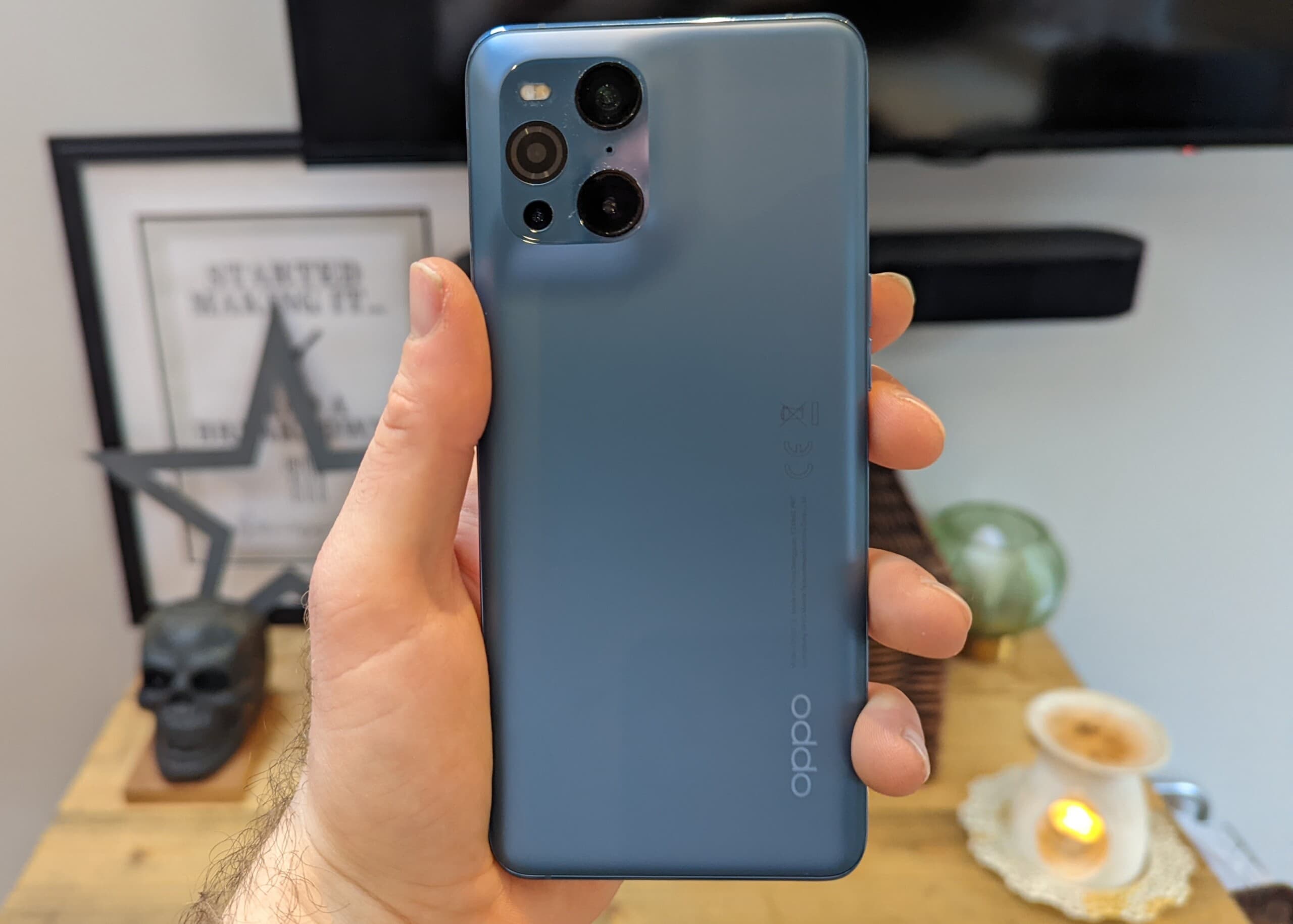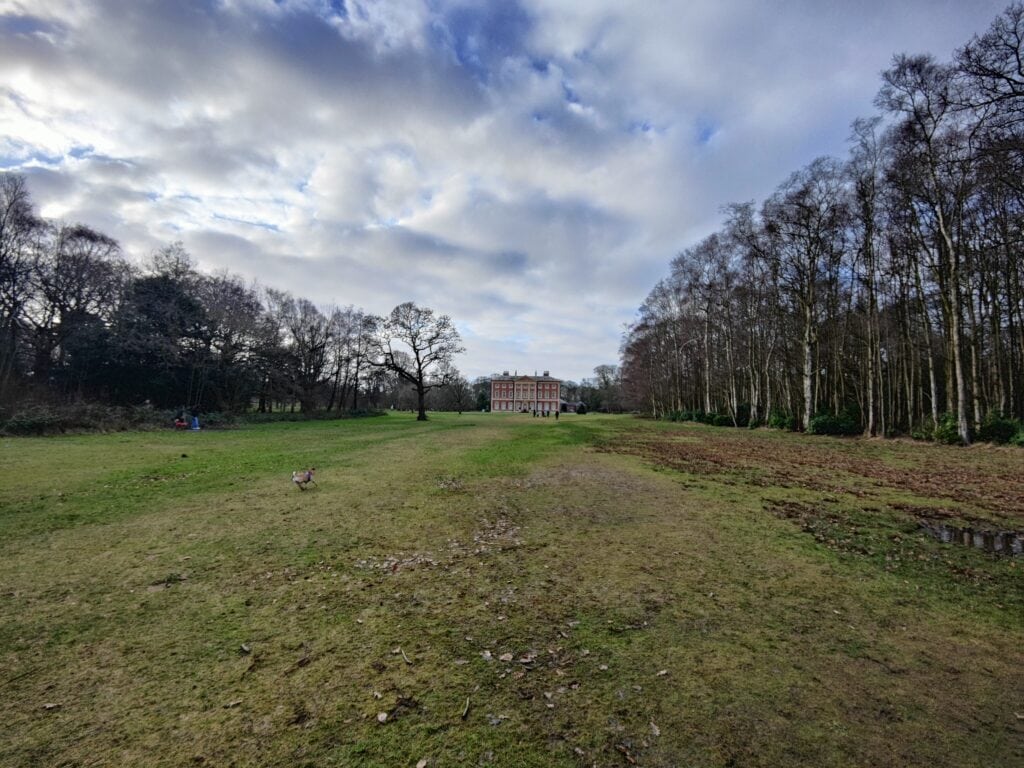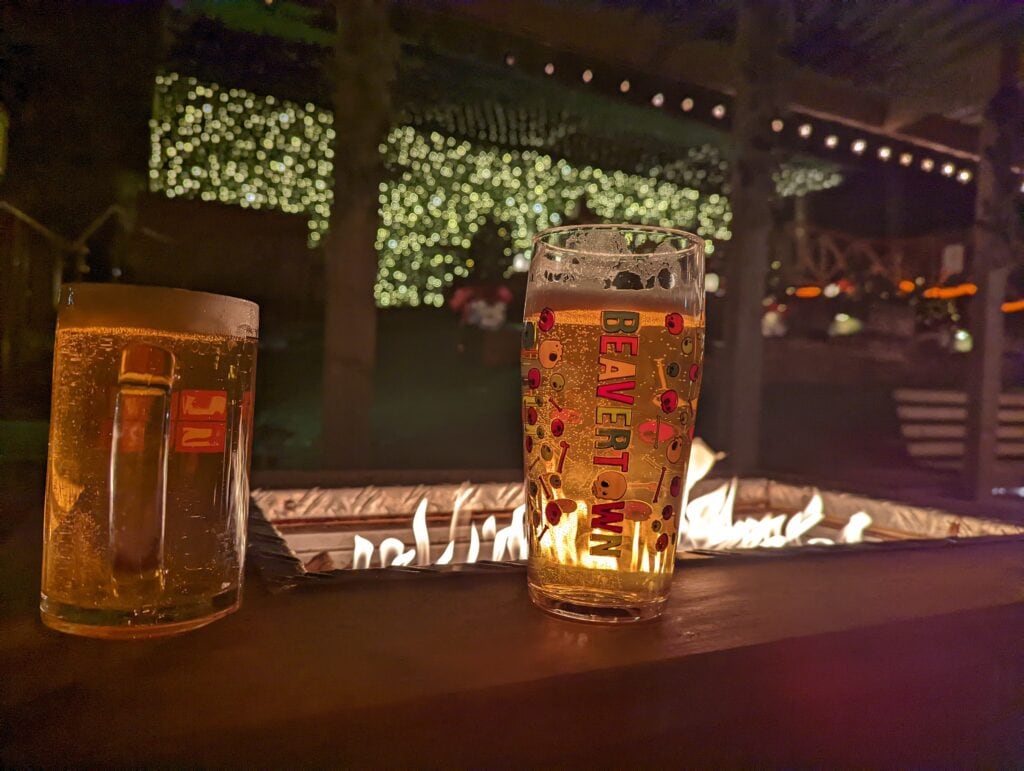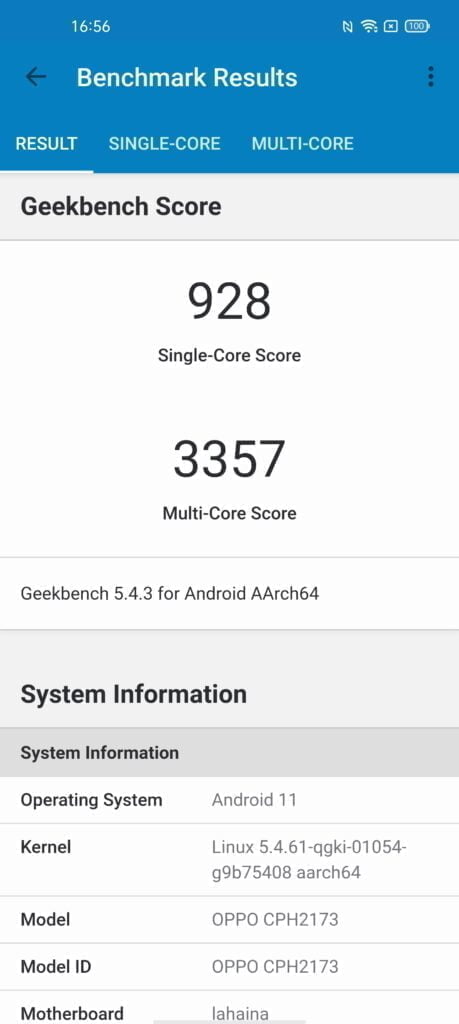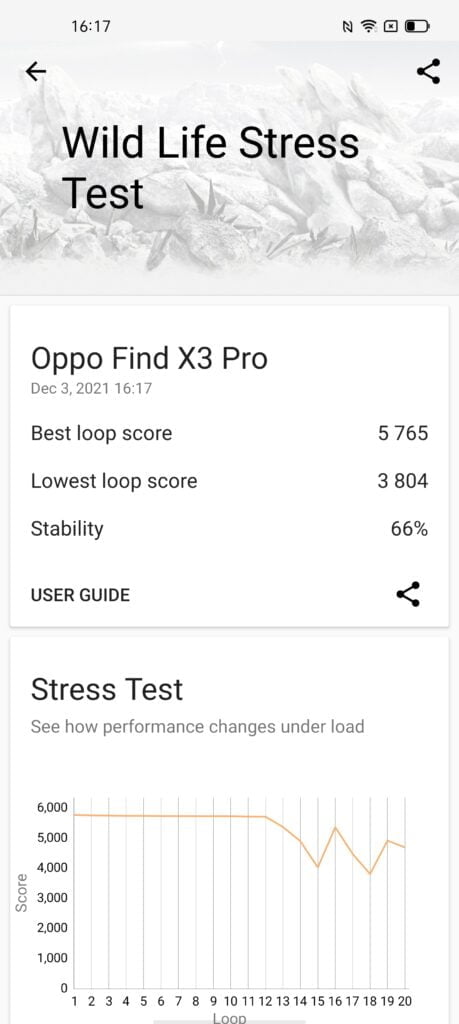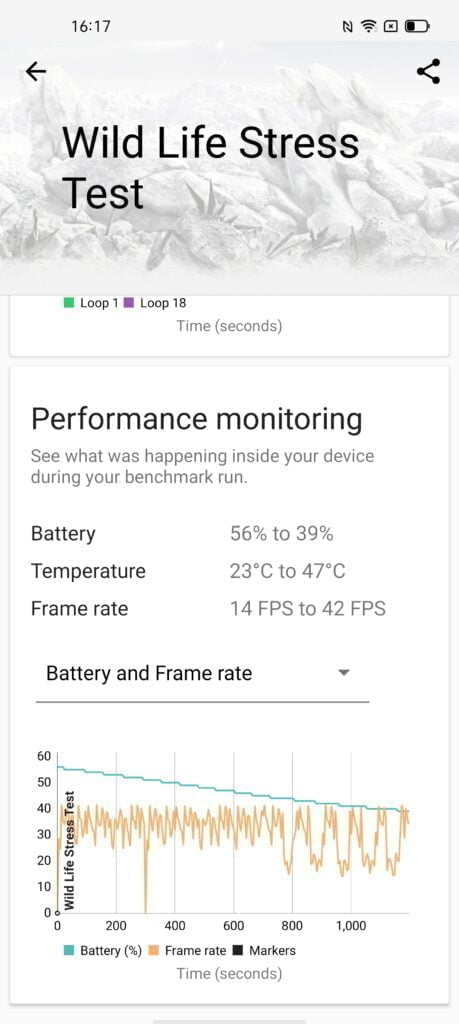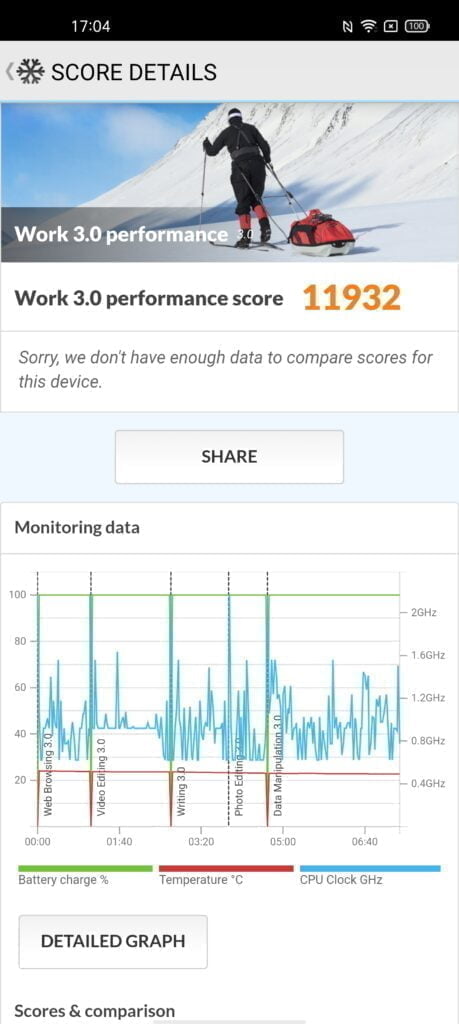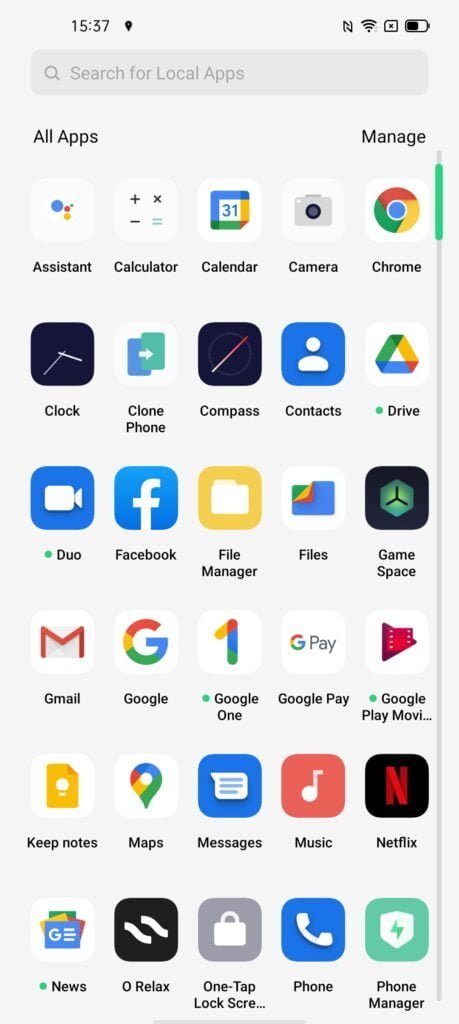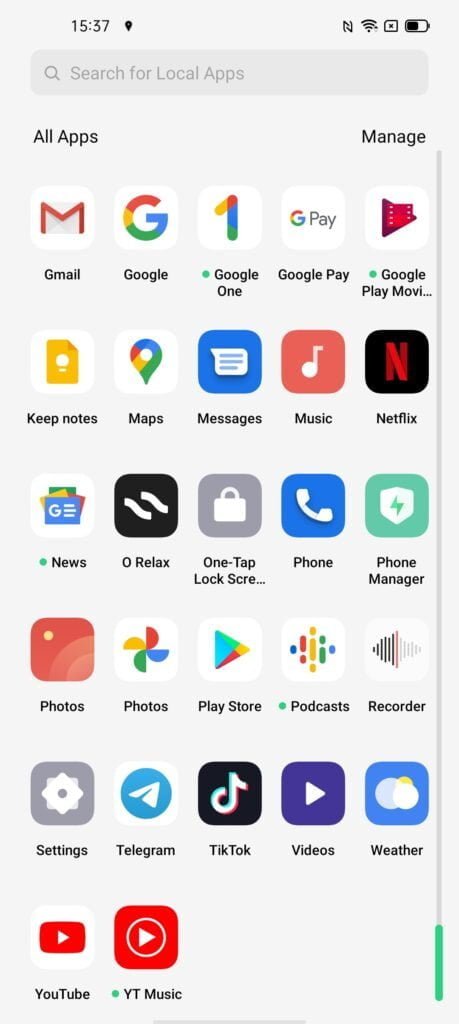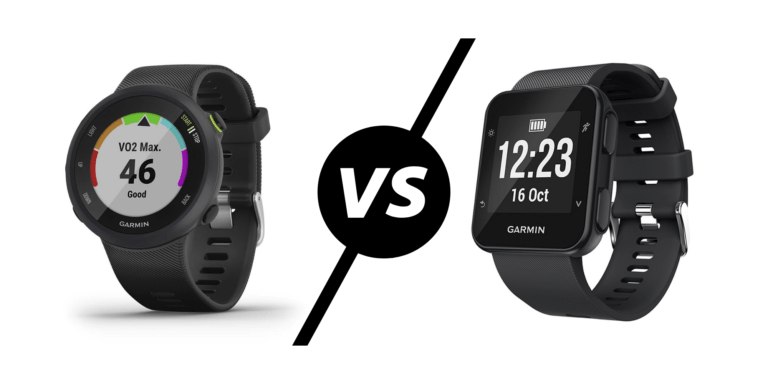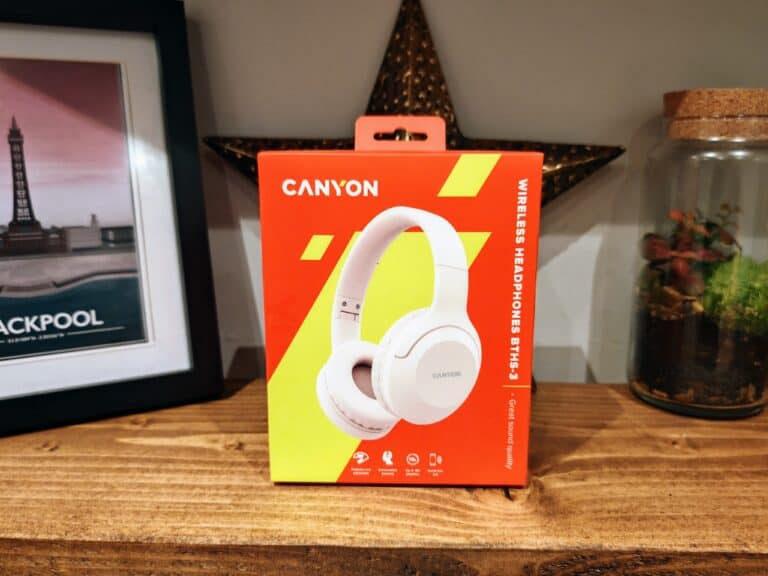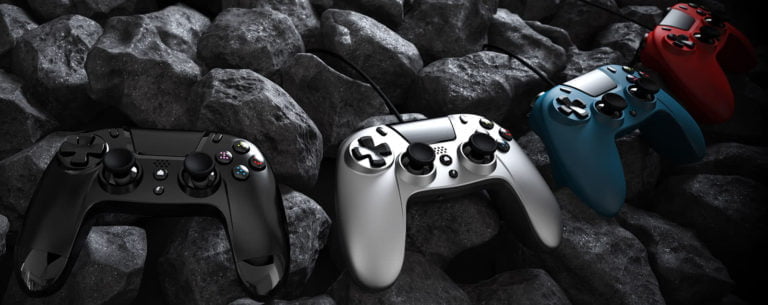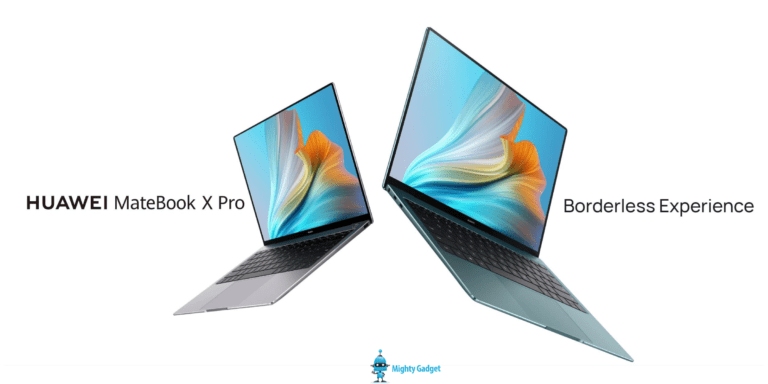Any links to online stores should be assumed to be affiliates. The company or PR agency provides all or most review samples. They have no control over my content, and I provide my honest opinion.
The OPPO Find X3 Pro was launched back in March 2021, so this review has come a little late. However, it is one of the highest specced phones of the year, with a price tag to match, and I didn’t want to pass on reviewing a phone of this calibre.
Due to the timing of this review, it is going to be hard to highly recommend that people buy it. Unless you get some significant discount on the RRP, you will likely be best waiting for the launch of 2022 flagships due over the next three months.
While I may not be recommending this phone to buy, is it one of the best phones of 2021 and can it compete with the Samsung Galaxy S21 Ultra?
| Preview | Product | Rating | Price | |
|---|---|---|---|---|

| OPPO Find X3 Pro 5G - 12GB RAM and 256GB Storage SIM Free... | £989.00 | Buy on Amazon |
Specification
| Specifications | Oppo Find X3 Pro |
|---|---|
| Display | 6.7-inch LTPO AMOLED Curved QHD+ 3,216 x 1,440 at 525PPI Adaptive 120Hz refresh rate HDR10+ certified |
| Processor | Qualcomm Snapdragon 888 |
| RAM | 12GB LPDDR5 |
| Storage | 256GB UFS3.1 |
| MicroSD | No |
| Battery | 4,500mAh 65W wired charging 30W wireless charging Reverse wireless charging |
| Rear Cameras | Rear: - Wide-angle: 50MP, ƒ/1.8, 1/1.56" sensor with OIS and all-pixel PDAF - Ultra-wide: 50MP, ƒ/2.2, 1/1.56" sensor with all-pixel PDAF - Telephoto: 13MP, ƒ/2.4, with 5x hybrid zoom - Microlens: 3MP, ƒ/3.0 with fixed focus |
| Front Camera | - 32MP, ƒ/2.4, with OIS |
| Connectivity | 4G LTE support 5G (sub-6GHz, SA and NSA) Wi-Fi 6 support Bluetooth 5.0 |
| Operating System | Android 11 (Color OS 11.2) |
| Water resistance | IP68 |
| Security | In-display fingerprint scanner, face unlock |
| Colour | Gloss Black, Blue |
| Dimensions and weight | 163.4 x 74 x 8.26 mm |
| 193g |
Design and Display
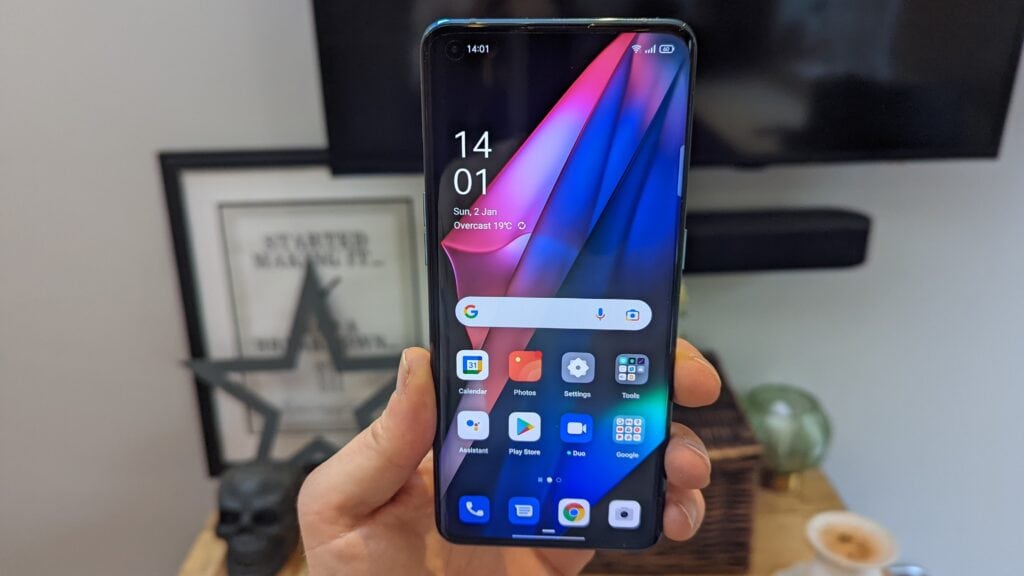
The OPPO Find X3 Pro is about as attractive as a phone can be. My sample is an attractive blue with a matte finish.
This is a very thin phone and feels surprisingly light in my hand. It comes in at 193g, making it lighter than the vast majority of flagship phones, most of which weigh well over 200g. The overall dimensions are suspiciously similar to the OnePlus 9 Pro, though this is a touch slimmer. The 6.7-inch display on both phones is likely identical.
The front and rear of the phone are Gorilla Glass 5, which is not quite as durable as Gorilla Glass Victus found on some other phones, but the phone comes with a pre-applied plastic screen protector and includes a free case, which is more than can be said for my Pixel 6 Pro.
I like the way the glass curves up into the camera rather than the standard camera bump that awkwardly protrudes out.
The phone has a 6.7-inch AMOLED screen with a QHD+ (or 3216 x 1440) resolution and 1300 nits max brightness. The screen then has a variable refresh rate of 120Hz. OPPO also claim this is a 1-billion-colour display with over 100% of the DCI-P3 colour gamut.
The display is curved, but it isn’t a deep curve, and I didn’t find it caused any usability issues. In particular, the included case doesn’t affect the touch sensitivity at the side of the phone.
The end result is one of the best displays I have used this year.
There is a small speaker grille at the top and bottom of the handset, which produces stereo audio using Dolby Atmos. I don’t use phone speakers much, but it is better than average.
It is worth pointing out that this has face unlock, which the Pixel lacks, and a good fingerprint scanner. Better than my Pixel, not as good as the Galaxy S21.
Camera
One of the main reasons why you would want to buy this phone is the camera specification. The camera specification and performance are what differentiates these premium-priced flagship phones from the more affordable flagship phones on the market.
This has:
- 50 MP primary camera with a 1/1.56″ sensor and OIS
- 13 MP 1/3.4″ 2x optical zoom sensor
- 50 MP 1/1.56″ ultra-wide camera
- 3 MP microscope camera with 60x magnification
The camera specification is very similar to the OnePlus 9 Pro. That has a slightly different primary sensor, 8MP 3.3x zoom telephoto, the same ultra-wide and then a 2MP mono vs the microscope.
In comparison to the Samsung Galaxy S21 Ultra 5G, which has a much more flexible telephoto set up with two different cameras, one a 10MP 10x zoom periscope lens and the other a 10MP 3x zoom lens.
Thanks to the weather and COVID, I haven’t had as much chance to use the camera in a wide range of conditions, but the overall performance is exceptional, which is to be expected from a £1k phone.
Both the main sensor and ultra-wide have performed great. I am a big fan of using a good quality sensor for the ultrawide, and I think this could be one of the factors that would swing me to buy this over other similarly priced phones.
Low light performance is good but not quite class-leading. Huawei still does best when it comes to dealing with very low light, and the Pixel is better for a more natural look.
OPPO was the first company to launch a phone with a periscope zoom lens. So, It is a bit odd that they have ditched it this year when so many other brands have adopted it. The telephoto performance is, therefore, a bit underwhelming. You could probably get similar if not better results using the 50MP Sony IMX766 and cropping the image.
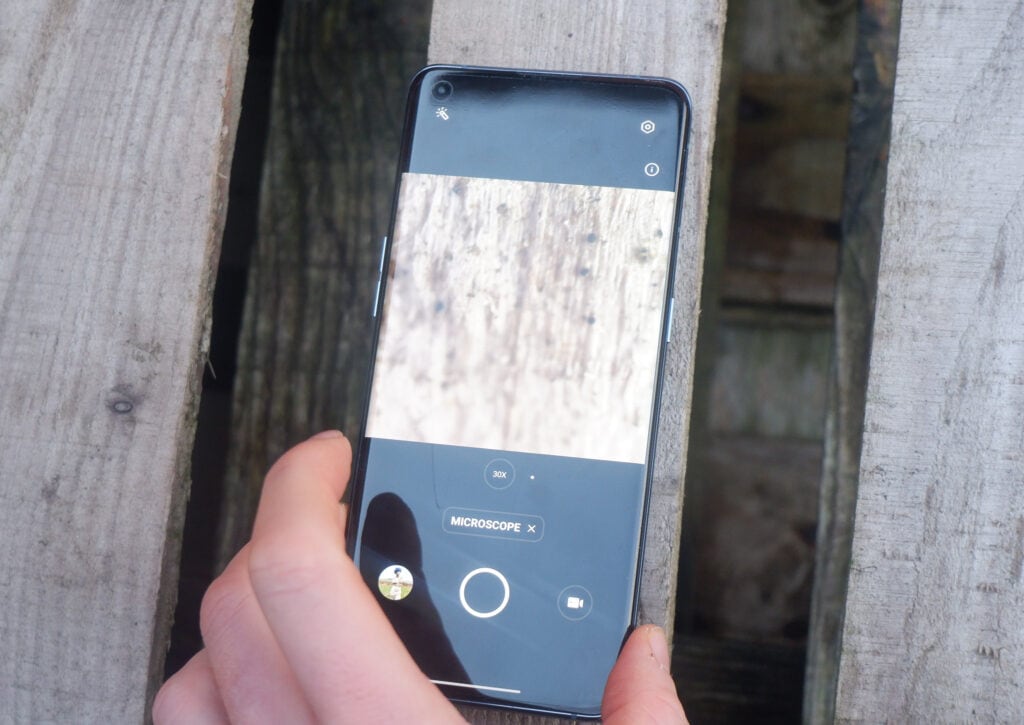
OPPO has avoided using the traditional mono/bokeh/macro lens, which tends to be relatively useless and used to pad out the camera numbers. Instead, they have included a 3MP microscope camera. It is fun to try out and certainly better than a macro lens but will also inevitably end up being rarely used.
Performance & Thermal Throttling
At this point, it is well documented how well the Qualcomm Snapdragon 888 performs and the thermal throttling issues it has.
Real-world, day to day performance is as good as it gets, apps load instantly, the UI is buttery smooth, and the phone is generally a pleasure to use.
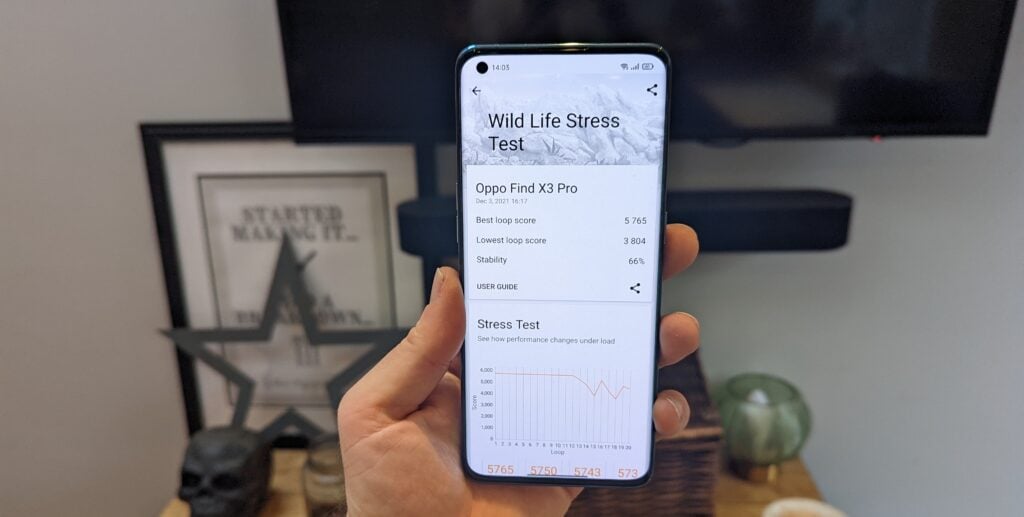
In comparison to my Pixel 6, I have recently noticed the occasional bit of lagginess. I am not sure if this is the 90Hz display or the Google Tensor chipset, but the overall experience isn’t quite as smooth or fast. Admittedly, I only really noticed this when switching between phones.
Benchmarks are as expected, albiet fractionally lower than some other similarily specced phones. Geekbench is a little below the Xiaomi Mi 11 and the OnePlus 9 Pro with the same chipset and also the Samsung Galaxy S21 with the Exynos 2100.
3DMark Wildfire is essentially identical to the other devices.
The Wild Life Stress test shows a stability score of 66%, with the scores taking a tumble at around the 12-minute mark. This is better than most devices this year, including the OnePlus 9 Pro and Samsung Galaxy S21. It is significantly better than the Realme GT and more recently, the Pixel 6 Pro which uses the Google Tensor chipset. It is only the Xiaomi Mi 11 and RedMagic phones that have better stability.
Battery
The phone is equipped with a 4500 mAh battery, the same as the OnePlus 9 Pro, but smaller than the S21 Ultra. It has 65W fast charging, which I am a big fan of, and 30W wireless, both of which are faster than the Samsung.
Unlike Samsung and Google, OPPO still includes a charger. This is worth factoring in, Google charge £25 for their 30W brick (with no cable) and OPPO sells additional 65W SuperVooc 2.0 plugs for £35.
With the phone using the power-hungry Snapdragon 888, the overall battery performance could be better. For a phone at this price, I’d would have been happier with a 5000+ mAh battery, but this would have made the phone thicker and heavier.
I was unable to complete the PCMark battery benchmark, the app crashed out each time I ran it. It appears to get to about 9 hours, which is a bit better than the OnePlus.
Real-world usage is adequate, I can just about comfortably get through the day without having to charge. If I was out and about for the day using maps and the camera a lot, I suspect I would get a little anxious and want to charge before the end of the day.
Software
I have reviewed quite a lot of OPPO, Realme and OnePlus phones over the past couple of years, so I have become quite familiar with ColorOS, and I generally like it. I’d even go as far as saying I prefer it to the stock experience on my Pixel 6.
There are some preinstalled apps that I’d prefer were not there. This includes AliExpress and TikTok, but they can be uninstalled.
Currently, the phone is running ColorOS 11.2, which is based on Android 11 the last update the phone had was on the 18 of October 2021, but as I wrote this review I got another which includes the November security update plus several stability updates.
OPPO officially states that this and the other X3 phones will get the security patch version once a month. It looks like OPPO have started the rollout for ColorOS 12 with Android 12. This began at the end of November in Malaysia, Thailand and Indonesia.
As I post this, it has just been revealed that Android 12 will start following out in France, Italy and Spain in January. UK is still classed as ongoing.
While I no longer have the Samsung Galaxy S21 Ultra, it appears that Samsung is more proactive with its updates. They are running Android 12 with the phone getting the stable upgrade of One UI 4 (based on Android 12) at the start of December. They also pushed out updates at the end of November and October.
Price and Alternatives
| Preview | Product | Rating | Price | |
|---|---|---|---|---|

| OPPO Find X3 Pro 5G - 12GB RAM and 256GB Storage SIM Free... | £989.00 | Buy on Amazon | |

| Samsung Galaxy S21 Ultra 5G Smartphone SIM Free Android... | Buy on Amazon |
The OPPO Find X3 Pro has an RRP of £1099, and at the time of writing, it is still this price at most retailers. The lowest it has been on Amazon is £999
The Samsung Galaxy S21 Ultra has an RRP of £1149 but is currently available for £968, and it has been as low as £900.
The Xiaomi Mi 11 Ultra is only available via Mi.com and is currently sold for its RRP of £1,199.
With it being so late in the year and so many new flagship phones due to launch in the next month or two, I wouldn’t recommend spending that much on any of the phones listed above. I would hope all three phones will get significant discounts once their successors are launched.
Overall
The OPPO Find X3 Pro is without a doubt one of the best phones of 2021, and it can easily hold its own against the superb Samsung Galaxy S21 Ultra. It has been so long since I reviewed the Samsung I can’t honestly say which phone I prefer, but the important thing is that OPPO is up there with the best of the best.
For Samsung, it had a much better battery life, superior telephoto lenses and a better fingerprint scanner. For OPPO, you have significantly faster charging and a far superior ultrawide camera. It is also less cumbersome, weighing in at over 30g less.
I was quite critical of the performance issues the Samsung Galaxy 21 Ultra had when I reviewed it at the start of the year. These problems then existed with every flagship phone this year. The SD888 has resulted in battery performance being worse this year compared to the SD865, and it is my biggest gripe of flagship phones in 2021. I am not hopeful that the Snapdragon 8 Gen 1 will be much better.
Of course, due to the timing of this review, I am not particularly recommending you buy the phone, but it is worth considering second hand. Amazon have a renewed model for just £718, which is probably a good buy; eBay has options under £600.
New prices should drop significantly in the next few months. The OPPO Find X2 Pro dropped down to £799 on Amazon at the end of March 2021.
OPPO Find X3 Pro Review Rating
Summary
The OPPO Find X3 Pro easily holds its own against the Samsung Galaxy S21 Ultra and is one of the best premium-priced flagship phones of 2021. With the price still remaining high, if this phone does interest you, you’d be better off waiting a couple of months for its successor.
Overall
80%-
Overall - 80%80%
Pros
- Beautiful display & overall design
- Superb primary and ultra-wide camera
Cons
- Price
- Mediocre telephoto lens vs rivals
I am James, a UK-based tech enthusiast and the Editor and Owner of Mighty Gadget, which I’ve proudly run since 2007. Passionate about all things technology, my expertise spans from computers and networking to mobile, wearables, and smart home devices.
As a fitness fanatic who loves running and cycling, I also have a keen interest in fitness-related technology, and I take every opportunity to cover this niche on my blog. My diverse interests allow me to bring a unique perspective to tech blogging, merging lifestyle, fitness, and the latest tech trends.
In my academic pursuits, I earned a BSc in Information Systems Design from UCLAN, before advancing my learning with a Master’s Degree in Computing. This advanced study also included Cisco CCNA accreditation, further demonstrating my commitment to understanding and staying ahead of the technology curve.
I’m proud to share that Vuelio has consistently ranked Mighty Gadget as one of the top technology blogs in the UK. With my dedication to technology and drive to share my insights, I aim to continue providing my readers with engaging and informative content.
Last update on 2025-07-13 / Affiliate links / Images from Amazon Product Advertising API

